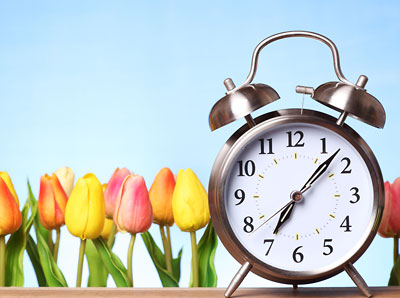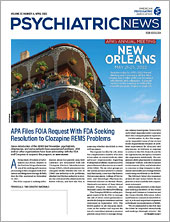The annual switch to Daylight Saving Time (DST) from March to November poses risks to mental and physical health, according to speakers at a virtual town hall held by the Society for Research on Biological Rhythms (SRBR) in December and at the virtual annual meeting of the Associated Professional Sleep Societies (APSS) last summer.
Remaining on Standard Time (ST) year-around would promote overall health and well-being, position papers by both groups say.
Sunlight exposure soon after awakening serves as the body’s most potent time-setting cue. By anchoring biological clocks such as the sleep/wake cycle to the earth’s 24-hour dark/light cycle, regular morning light exposure helps foster good mental health, Karen Gamble, Ph.D., co-chair of the SRBR meeting, told Psychiatric News. Daily morning light exposure in the winter provides greater benefits to mental health than does increased outdoor activities on summer evenings, said Gamble, the Tate Jordan Thomas Professor of Psychiatric Medicine and Vice Chair of Basic Research in Psychiatry and Behavioral Neurobiology at the University of Alabama at Birmingham.
During ST, clock time aligns with sun time, Elizabeth Klerman, M.D., Ph.D., a professor of neurology and sleep researcher at Harvard Medical School, said at the APSS meeting.
When DST is in effect, clock time shifts an hour later, while sun time stays the same, she noted. People get less light exposure early in the day and more later in the day. Biological clocks fall out of sync with the sun. Misalignment is greatest in the western part of each time zone, where the sun rises later. About 70 countries observe DST in whole or in part.
Switching from ST to DST differs from flying across time zones, when both clock time and sun time shift but remain aligned with each other, Klerman said. Body clocks adapt to new time zones in about a day for each time zone crossed. Body clocks do not adjust to DST, even after many months, according to SRBR’s 2019 position paper highlighting advantages of ST over DST. Klerman was a co-author.
During DST, many people stay awake later in the evening because it’s lighter outside later by clock time. When they arise at their usual clock time for work or school, they get less sleep, Klerman said, reducing daytime alertness and decision-making ability. The spring change to DST, she said, has been associated with an increased risk of mood disturbance and suicide.
DST amplifies sleep and health disparities in low-income populations, said Karin Johnson, M.D., an associate professor of neurology at the University of Massachusetts Medical School-Baystate and medical director of the Baystate Regional Sleep Medicine Program. Black and Latino workers in the U.S. are more than twice as likely as Whites to start work between midnight and 6 a.m., she said. They also get less sleep. Unlike people with more flexible work hours who can enjoy outdoor recreational activities in the evening, she said, these groups don’t derive an entertainment benefit from light later in the day.
The six or seven months that DST is in effect while schools are in session exacerbate adolescent sleep deprivation, said Johnson, who chairs the sleep section of the American Academy of Neurology. While teenagers’ biological clocks normally push them to stay up later, DST prompts them to stay awake later still. DST undercuts advantages of recent progress in starting school later. Starting classes at 8:30 a.m. DST, for example, she said, is comparable to starting them at 7:30 a.m. ST.
A position statement issued by the American Academy of Sleep Medicine (AASM) in 2020 recommended that the U.S. abolish seasonal time changes and adopt ST nationally year-round. The position statement noted that shifting from ST to DST has been associated with increased cardiovascular morbidity, including risk of myocardial infarction, stroke, and hospital admissions for acute atrial fibrillation, as well as medical appointments, emergency room visits, and return hospital visits. U.S. traffic fatalities increased by 6% in the week after the spring transition to DST, especially in the morning, while afternoon rush-hour crashes did not fall, despite added daylight, according to a study of more than 700,000 fatal motor vehicle crashes in all states between 1996 and 2017.
This strong evidence supports abolishing seasonal time changes, Muhammad A. Rishi, M.B.B.S., a pulmonologist at the Mayo Clinic in Eau Claire, Wis., and vice-chair of the AASM committee that produced the position statement, said at the APSS meeting. AASM’s statement has been endorsed by 19 medical and health organizations to date, including the SRBR, which provides DST resource information on its website.
Three in four Americans dislike the annual time switch, Jay Pea, a software engineer, founder of the San Francisco-based nonprofit organization Save Standard Time, and an SRBR meeting speaker, told Psychiatric News. About 43% prefer year-around ST, while 32% favor permanent DST, he said, according to a survey of 1,083 adults representative of the U.S. household population conducted last October by The Associated Press-NORC Center for Public Affairs Research and funded by The Associated Press and NORC at the University of Chicago.
This survey posed the question even-handedly, Pea said, asking, “Would you prefer to use Daylight Saving Time all year-around, Standard Time all year-around or switch back and forth between them?” Some polls, he said, have asked, “Do you prefer summer time or winter time?” skewing results to favor DST. ■
The Society for Research on Biological Rhythms Position Paper, “Why Should We Abolish Daylight Saving Time?” is posted
here.
“Daylight Saving Time: An American Academy of Sleep Medicine Position Statement” is posted
here.
The AP-NORC Survey findings are posted
here.

